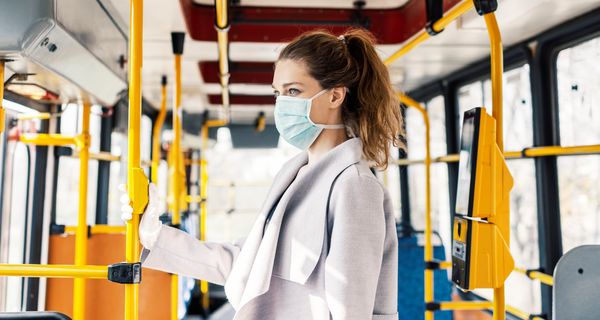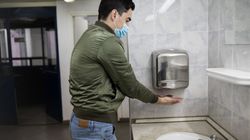We’re here to guide you through the coronavirus pandemic. Sign up to the Life newsletter for daily tips, advice, how-tos and escapism.
Everyone should have a face covering and no one should leave home without one, the president of the UK’s national academy of science has said.
Venki Ramakrishnan, from the Royal Society, said they should be worn “whenever you’re in crowded spaces”. “The virus has not been eliminated, so as we lift lockdown and people interact with each other, we need to use every tool we have to reduce the risk of a second wave of infection,” he said.
“There are no silver bullets but alongside hand washing and physical distancing, we also need everyone to start wearing face coverings, particularly indoors in enclosed public spaces where physical distancing is often not possible.”
Face masks are already mandatory on public transport in England and Scotland, and soon to be mandatory in shops in the latter, too – so it’s a good idea to get up to speed on why we’re wearing them and how we can do so as comfortably as possible.
From knowing how to fit one properly, to tips and tricks for avoiding fogging up your glasses, here are seven things you should know.

1. Wearing a face mask protects other people.
Face masks protect other people from your germs. As Professor Chris Whitty, England’s chief medical officer, explained: “Wearing a face covering is an added precaution that may have some benefit in reducing the likelihood that a person with the infection passes it on.”
And Paul Edelstein, professor of pathology and laboratory medicine at the University of Pennsylvania, said: “The evidence for the benefit of wearing face coverings in protecting others from infection is becoming clearer all the time.”
Face masks are key to reducing the virus’ spread among asymptomatic individuals (people who don’t have any symptoms). The Centers for Disease Control and Prevention (CDC) in the US estimated that just over a third (35%) of Covid-19 infections are symptomless. Meanwhile a study of 9,000 people in Iceland found 50% of them were asymptomatic.
Studies from cruise ships suggest that figure could be even higher. Almost three quarters (72%) of people on board the Diamond Princess cruise ship who had Covid-19 were thought to have been asymptomatic, according to a preliminary study by the London School of Hygiene & Tropical Medicine.
2. It has to cover your nose and mouth to work properly.
You’ve probably spotted people wearing face masks over their mouths, but not their noses – this doesn’t offer much protection. You have to cover your nose and mouth, as you can you expel droplets carrying the virus from both of them.
Having a face mask that fits properly is key to keeping your germs to yourself. University of Edinburgh researchers tested the effectiveness of seven types of mask – including medical-grade masks, homemade masks and face shields – to see how well they stopped the wearer’s germs from escaping.
Wearing a face mask or other covering over the mouth and nose was found to reduce the forward distance of your breath – which can carry the virus – by more than 90%. But having gaps at the back and sides of your mask could be problematic because strong jets of air can escape if masks are ill-fitting – so wearers (and those around them) need to be cautious.
3. It’s not a replacement for social distancing.
It’s also not a replacement for regular hand-washing (remember the 20-second rule), both of which remain the most important actions for stopping Covid-19 in its tracks.
4. There are ways to stop your ears from hurting.
Face masks and covers can make the backs of your ears sore, especially if you’ve been wearing them for some time.
Nurses and other healthcare professionals have been finding workarounds for this discomfort by attaching the ear loops of their face masks to hair styles and fastening buttons onto baseball caps or headbands to attach the ear loops to.
It might also be helpful to buy face covers with ribbon ties rather than elasticated ear loops, if you’re struggling with sore ears.
5. Face masks with front valves may not protect others.
Some types of respirator mask come with a valve on the front designed to filter out harmful particles – while these protect the wearer, they don’t protect other people from the wearer’s germs, according to experts. As the San Francisco Department of Public Health explains: “The ones with the valves or openings on the front are not safe, and may actually propel your germs further.”
Dr Ali Raja, executive vice chair of the department of emergency medicine at Massachusetts General Hospital and an associate professor at Harvard Medical School, told Healthline: “The virus can be transmitted through the valves, which offer no filtration at all. Any mask with a one-way valve is only going to protect the person wearing it. It won’t protect anyone around that person from potential exposure to virus particles they exhale.”
6. There’s a hack to stop your glasses steaming up while wearing masks.
If you’re sick of your glasses steaming up when wearing a mask, try inserting a paper clip into the lining of the mask around the nose area so the mask fits flush to the top of your nose.
This particular hack was shared by Trisha Greenhalgh, professor of primary health care services at the University of Oxford. If that doesn’t work, keep your glasses on top of your face mask or invest in an anti-fog spray to keep your lenses clear.
7. You don’t have to buy a face mask or cover.
If cash is tight and you’d rather not invest in a face cover, you can make one quite easily at home without having to fork out for materials. You can use a handkerchief, bandana, old t-shirt or even a sock. Some of them require sewing skills, but most are pretty foolproof.





